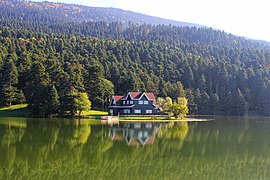Bolu Province
This article contains wording that promotes the subject in a subjective manner without imparting real information. (February 2018) |
Bolu Province
Bolu ili | |
|---|---|
 Lake Gölcük | |
 Location of the province within Turkey | |
| Country | Turkey |
| Seat | Bolu |
| Government | |
| • Governor | Erkan Kılıç |
| Area | 8,313 km2 (3,210 sq mi) |
| Population (2022)[1] | 320,824 |
| • Density | 39/km2 (100/sq mi) |
| Time zone | UTC+3 (TRT) |
| Area code | 0374 |
| Website | www |

Bolu Province (Turkish: Bolu ili) is a province situated in north-western Turkey. It is located between the capital, Ankara, and the largest city in the country, Istanbul. Its area is 8,313 km2,[2] and its population is 320,824 (2022).[1] The capital city of the province is Bolu.
Geography
The province is drained by the Bolu River (Boli Su) and the Koca River.
The forests, lakes, and mountains are rich in wildlife including three deer species, and popular weekend and holiday retreats for walkers and climbers.
Parts of the province are vulnerable to earthquakes.
History
It is not known when Bolu was first founded. Some archaeological findings date back about 100,000[citation needed] years that suggest the region was inhabited then.
The area now in Bolu Province was in eastern
The Byzantine Empire briefly lost the Bolu area to the
About 1240 the
By 1265, the western part of the Bolu area was again acquired by the Seljuk Turks, but it fell to the arms of
Administrative divisions
Bolu province is divided into nine districts, four sub-districts, thirteen municipalities, and 491 villages.
Districts

Main sites
- Lake Abant, a mountain lake resort and hot springs
- Yedigöller National Park. The name means "seven lakes" in Turkish, referring to the number of lakes in this forest park.
- The Epic of Köroğlu
- There are many hot springs and mineral baths in the province (kaplıcaları in Turkish).
- Kartalkaya, one of Turkey's most popular ski resorts
- Sarıalan, a lake high in the mountains above Kartalkaya
- The Aladağ mountains, including the trail and picnic area of Gölcük
- Seben Çeltikler
- AkshemseddinMausoleum
Towns include:
Gallery
-
Bolu Gölcük Nature Park Aerial View
-
Mist early in the morning
-
A scene fromYedigöller
-
Bolu Gölcük Nature Park side view of the State Guesthouse
-
Snowy wooden house
See also
References
- ^ TÜİK. Retrieved 19 September 2023.
- ^ "İl ve İlçe Yüz ölçümleri". General Directorate of Mapping. Retrieved 19 September 2023.
- ^ All About Turkey - Bolu
- ^ Memnon, History of Heracleia, 12
- ^ Naval staff, Intelligence Department (Royal Navy) (1919). A handbook of Asia Minor. Vol. 1. London. p. 226.
{{cite book}}: CS1 maint: location missing publisher (link)
External links
- (in Turkish) Official website
- (in Turkish) Bolu municipality's official website





